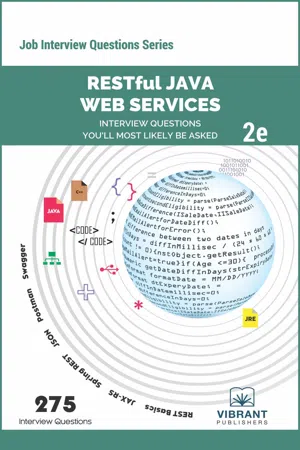
RESTful Java Web Services Interview Questions You'll Most Likely Be Asked
Second Edition
- English
- ePUB (mobile friendly)
- Available on iOS & Android
RESTful Java Web Services Interview Questions You'll Most Likely Be Asked
Second Edition
About this book
· 200 RESTful Java Web Services Interview Questions
· 75 HR Interview Questions
· Real life scenario-based questions
· Strategies to respond to interview questions
· 2 Aptitude Tests
These questions are across a wide range of topics. Some of the topics included are:
- REST Basics (Introduction to REST, HTTP, etc)
- JAX-RS (Standard Java API for REST services)
- Spring REST (Another very popular REST implementation for Java)
- JSON (Data interchange format for REST)
- Postman (Very popular testing tool for REST services)
- Swagger (Very popular documentation tool for REST)
RESTful Java Web Services Interview Questions You'll Most Likely Be Asked is a perfect companion to stand ahead above the rest in today's competitive job market. Rather than going through comprehensive, textbook-sized reference guides, this book includes only the information required immediately for job search to build an IT career. This book puts the interviewee in the driver's seat and helps them steer their way to impress the interviewer.
Includes:
a) 200 RESTful Java Web Services Interview Questions, Answers and proven strategies for getting hired as an IT professional
b) Dozens of examples to respond to interview questions
c) 75 HR Questions with Answers and proven strategies to give specific, impressive, answers that help nail the interviews
d) 2 Aptitude Tests download available
Frequently asked questions
- Essential is ideal for learners and professionals who enjoy exploring a wide range of subjects. Access the Essential Library with 800,000+ trusted titles and best-sellers across business, personal growth, and the humanities. Includes unlimited reading time and Standard Read Aloud voice.
- Complete: Perfect for advanced learners and researchers needing full, unrestricted access. Unlock 1.4M+ books across hundreds of subjects, including academic and specialized titles. The Complete Plan also includes advanced features like Premium Read Aloud and Research Assistant.
Please note we cannot support devices running on iOS 13 and Android 7 or earlier. Learn more about using the app.
Information
INDEX
Table of contents
- Introduction to REST
- Rest Resources, HTTP Methods and Status Codes
- Java REST APIs and Implementations
- JAX–RS Basics
- JAX–RS Request Handling
- JAX–RS Response Handling
- JAX–RS Exception Handling
- JAX–RS Client
- JAX–RS Filters
- JAX–RS Asynchronous Processing
- JAX–RS Security
- JAX–RS Miscellaneous
- Spring REST Basics
- Spring REST Request Processing
- Spring REST Response Processing
- Spring REST Exception Handling
- Spring REST Client
- JSON
- Postman
- Swagger
- Miscellaneous
- HR Interview Questions
- INDEX